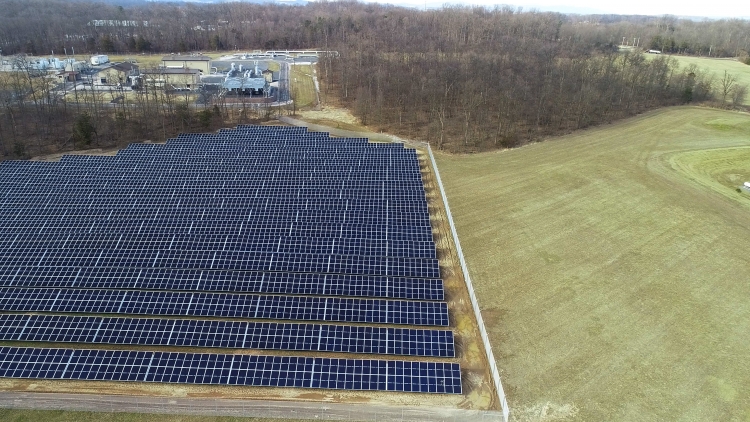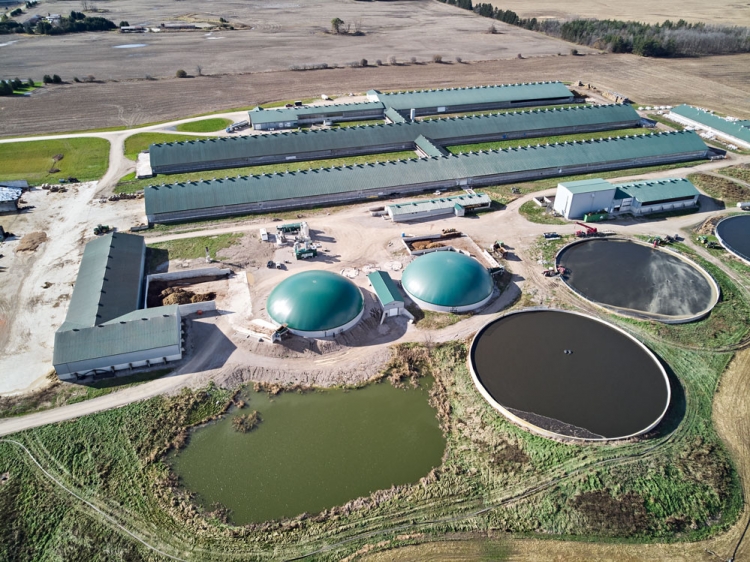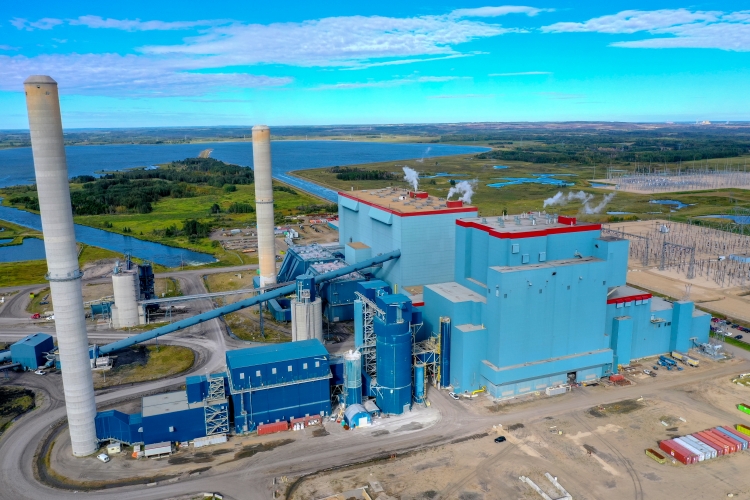Innovation + Diversification = Net Zero
Enbridge Gas – which serves 3.8mn natural gas customers in Ontario, Canada’s most populous province – was a leader among North American natural gas utilities when it set a target in November 2020 to reach net zero in its Scope 1 and Scope 2 emissions by 2050.
In addition, the company is advancing zero and low-carbon gasses such as hydrogen and RNG, and green technologies for heat and transportation, to help Ontario reach its emission reduction targets.
Achieving that goal economy wide, however, will require a complex combination of increased electrification, largely in building heat systems, light industrial applications and personal and light-duty vehicles, and a greener gas supply, achieved through adding renewable natural gas and hydrogen to the mix, and an industrial complex powered by hydrogen and blended natural gas, with carbon capture and storage (CCS) to decarbonise point-source emissions.
“A diversified pathway, with low carbon fuels, natural gas with carbon capture and coordination with the electricity sector, will deliver net zero 27% cheaper and far more reliably because you'll be leveraging the underground infrastructure we have today to deliver greener fuels, thereby reducing the buildout of peak power needed to serve increased electricity demand,” Malini Giridhar, vice president, business development and regulatory at Enbridge Gas, tells NGW in an interview. “The point is there isn’t a single solution; multiple technologies and solutions are possible, and they may fit differently for different circumstances – we’re looking at all these solutions and very much focused on figuring out what tools we can use to decarbonise.”
To help inform its decisions on decarbonisation, and to support future regulatory proceedings before the Ontario Energy Board (OEB) as it implements RNG, hydrogen and low-carbon technology programmes, Enbridge Gas commissioned a report from cross-sectoral consultancy Guidehouse to examine how Ontario’s energy systems can support the achievement of net zero by 2050 in Ontario, and identify what investments in electricity, hydrogen and natural gas would be required.
“The findings from that analysis…concluded that a diversified approach that includes a targeted approach to electrification tied with deployment of low- or zero-carbon gases, including renewable natural gas (RNG), hydrogen and natural gas with carbon capture, is the most cost-effective and resilient method to achieve net zero emissions in Ontario,” it says in its report, delivered in June 2022.
Guidehouse produced two scenarios under which Ontario could achieve its net zero aspirations, one which followed an “electrify everything” strategy favoured by many environmental organisations, and one which adopts a diversified strategy in which low- and zero-carbon gases and the existing gas delivery infrastructure are used in combination with targeted electrification to reduce greenhouse gas emissions in all sectors.
The diversified scenario saves about $202bn by 2050 compared to the electrification scenario, the report says, largely because less new electric infrastructure is needed to meet peak demand – which will quadruple in the electrification scenario and double in the diversified scenario.
Secure and reliable
As the world transitions its energy mix to a lower-carbon future, Enbridge is addressing the challenge of that evolution: provide secure and reliable energy while also respecting environmental aspirations like net zero.
“The way Enbridge looks at secure and reliable energy is that it comes from secure and reliable countries – and we certainly see that Canada can play a big role in providing that,” Giridhar says. And the first piece about supplying secure and reliable energy is how do we make our own energy use more sustainable, how do we invest in low-carbon forms of energy, how can we reduce our own emissions.”
To get to a more sustainable energy future, Enbridge, the midstream parent of Enbridge Gas active in gas transmission, distribution, storage and liquids pipelines, is working to modernise its networks, bring new innovations into play to help reduce and avoid emissions and develop broader capabilities to deliver low-carbon gases like renewable natural gas and hydrogen to its customers.
The largest modernisation effort is being rolled out in Enbridge’s gas transmission and midstream (GTM), where a US$2.1bn programme to replace older, less efficient natural gas-fired compressors will increase compressor station efficiency and system reliability while reducing GHG emissions by 25%.
“The first phase is expected to reduce GHG emissions on our Texas Eastern pipeline by more than 180,000 tCO2e annually beginning in 2024, and our second phase will further reduce emissions,” Enbridge says in its 2021 Sustainability Report. “Additional modernisation works include piloting methane abatement technologies and changing design and operating standards.”
Those technologies, Giridhar says, include deploying blowdown recovery units that capture methane during maintenance that would otherwise be vented.
“We are very committed to best practices, and we’re actively looking at both fugitive and vented emissions and technologies,” she says. “We’re very focused on taking a granular look at where these emissions occur.”
Distribution utilities across North America lose an estimated 1% of their total throughput to vented or fugitive emissions, Giridhar says, but Enbridge has measured its own vented and fugitive emissions at about 0.08% of throughput, or ten times better than the North American average.
“But we’re not resting on that, we’re continuing to look at bringing them as close to zero as possible.”
A range of approaches are in place at Enbridge’s GTM and gas distribution and storage (GDS) facilities to detect and reduce methane emissions, it says in its Sustainability Report. Methane emissions in 2021 were 12% lower than in 2020 and 20% lower from its 2018 baseline level.

Enbridge has installed solar power facilities at its Heidlersburg compressor station in Pennsylvania. [Image credit: Enbridge]
To address its Scope 2 emissions and reduce its power costs, Enbridge is rolling out on-site solar facilities to power electric compressors and pumps at its stations. The first two of those are operating at compressor stations on the Texas Eastern Transmission system in Pennsylvania and New Jersey, while in Alberta, the 10.5 MW Solar One facility is contributing a portion of the power requirements for the Enbridge Mainline oil and liquids network, which extends from Alberta to refineries eastern Canada and the US Midwest.
“We currently have 10 more projects under construction across our liquids and gas transmission systems,” Enbridge says in its Sustainability Report. “In total, with these 13 approved projects we expect to reduce emissions by more than 858,000 tCO2e by 2030 with further avoided emissions over the 30-year life of the projects.”
Decarbonising the gas mix
The world’s future energy mix, Giridhar says, is increasingly going to feature low-carbon fuels, both liquid and gaseous, but what exactly that mix will be in various regions remains unclear. Enbridge’s task, she says, is to keep pace with what the world wants and deliver it through secure and reliable infrastructure.
“While we see that natural gas will be needed for a long time to come, we’re not betting just on that; we are very focused on new energies as well,” she says. “The key for us is to keep pace with the way energy transition occurs.”
In recent years, its focus has been on developing low- and zero-carbon gases like RNG and hydrogen in Ontario and elsewhere and on CCS in western Canada to mitigate point source emissions and facilitate blue hydrogen.

Stanton Farms, home to Ontario's first farm-based RNG facility. [Image credit: Enbridge]
In October 2022, Stanton Farms commissioned Ontario’s first farm-based RNG facility and began delivering an estimated 3mn m3/year of RNG into Enbridge Gas’ distribution system.
Enbridge itself, in partnership with Walker Industries and Comcor Environmental, is nearly ready to commission what will be Ontario’s largest RNG plant in Niagara Falls. The $42mn project will capture landfill gas, clean it and transform it into RNG for injection into Enbridge’s distribution system, reducing GHG emissions by about 48,000 mt/yr.
And it has entered into a partnership with Vanguard Renewables to develop eight RNG projects sites in the US. Vanguard will build and operate anaerobic digesters to convert food and farm waste to biogas, while Enbridge will invest in the upgrading equipment to turn biogas into pipeline-quality RNG.
On the customer-facing side, in 2021, the utility launched a voluntary program, OptUp, which invites its Ontario-based residential customers to pay an additional $2/month to take a portion of their requirements as RNG – greening the utility’s gas supply and supporting Ontario’s environment plan.
In a recent regulatory filing with the OEB, Giridhar says, the utility has put forward a proposal to blend up to 4% RNG into its system supply starting in 2025.
Alongside its efforts to decarbonise natural gas system supply with RNG, Enbridge is also working to provide cost-effective decarbonisation solutions for the heavy transport sector. The City of Toronto is using carbon-negative RNG sourced from Enbridge to fuel garbage trucks, while the City of Hamilton is operating the province’s first carbon-negative transit bus, also fueled with RNG from an Enbridge-supported biogas-to-RNG facility in London, Ontario.
“From our perspective, we do think RNG should be first because it is cheaper than hydrogen,” Giridhar says. “But we do want to do all of the necessary work that will enable more hydrogen blending in our system.”
Hydrogen
Enbridge has been among the first movers in Canada on the hydrogen front, beginning in 2018 when it developed North America’s first utility-scale green hydrogen plant in Markham. That facility is now producing hydrogen that, in another North American first, is being blended – in small volumes – into a portion of the Enbridge Gas system serving about 3,600 customers in Markham.
Enbridge's Markham hydrogen blending facility in Ontario. [Image credit: Enbridge]
“We’re also looking at doing this for a utility in Quebec, Gazifère, which is interested in planning for 45,000 customers,” Giridhar says. “And we’re looking at doing an engineering study that would assess what kind of blending proportions we should target for Enbridge Gas’ Ontario network.”
Enbridge Gas is also partnering with 2G Energy and CEM Engineering to install this year a 115 kW combined heat and power (CHP) system at its Technology and Operations Centre in Markham capable of operating on natural gas or a blend of gas and hydrogen ranging from 25% to 100% hydrogen.
At 100% hydrogen utilisation, the system would consume about 78,000 kg/yr of hydrogen and avoid about 133 mt/yr of CO2-equivalent emissions, Enbridge says.
Both the Markham blending project and the CHP facility will rely initially on green hydrogen, but Giridhar says Enbridge does have aspirations to participate in the production of blue hydrogen – it needs the legislative and regulatory environment in Ontario to catch up and allow CCS.
“The industrial areas of Sarnia and Hamilton could benefit from CCS in the future, so we’re very keen to get going,” she says. “It does require some legislative changes in Ontario – we don’t yet have the ability to sequester CO2underground in Ontario.”
Enbridge is, however, active in CCS elsewhere in Canada. In Alberta, it is partnering with power utility Capital Power to develop the Open Access Wabamun Carbon Hub west of Edmonton. The hub, which is part of Alberta’s first phase of CO2 hub developments, would capture an estimated 4mn mt/yr of CO2 from Capital Power’s gas-fired Wabamun generating complex and Lehigh Cement’s plant in Edmonton.

Enbridge is developing its Open Access Wabamun Carbon Hub to capture emissions from Capital Power's station there. [Image credit: Enbridge]
“We do like the Alberta model, and the Enbridge Wabamum project in Alberta would be a really good model for us to try and bring in here, both in terms of the regulatory framework for the manner in which the pore space is competitively bid out and in the ability to bring in industrial customers to anchor the project with long-term contracts – to create almost a CCS utility,” Giridhar says.
Getting there
None of this, however, can happen in a vacuum, and Giridhar says much work needs to be done, at both the federal and provincial levels in Canada, to help Canadian industry make the decarbonisation investments that are needed.
“We’re seeing comparisons with what the Inflation Reduction Act is doing south of the border – we must keep pace with that,” she says.
Canadian industry is also at a disadvantage due to the lack of regulatory and permitting clarity – issues that have also been addressed by the US in the Inflation Reduction Act. Enbridge can follow the advantages available in the US, Giridhar says, but it’s equally important for Canada to compete on the same footing as the US.
“At a high level, those are some of the policy directions we’d like to see coming out of the government – making it competitive to invest in decarbonisation technologies and making it possible for us to invest in energy infrastructure through a clear permitting and regulatory system in Canada.”
The latest in a continuing series featuring the work of Gas Pathways Platform partners in advancing natural gas innovation.




